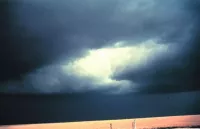Flash floods are rapid inundations of low-lying areas, characterized by a swift onset (less than six hours between rainfall and flooding). They are typically triggered by intense rainfall from severe thunderstorms, hurricanes, or tropical storms, as well as melting ice and snow. Catastrophic events like the collapse of natural ice or debris dams, or man-made structures such as the Johnstown Flood of 1889, can also cause flash floods.
2005: U.S. National Weather Service report on flood fatalities
In 2005, the U.S. National Weather Service reported that, based on a 30-year national average, floods caused more yearly deaths (127 on average) than lightning (73), tornadoes (65), or hurricanes (16).
2006: Analysis of flash floods in the United States begins
Beginning in 2006, analysis of flash floods in the United States shows that injuries and fatalities are most likely in small, rural catchments, the shortest events are the most dangerous, hazards are greatest after nightfall, and a high fraction of injuries and fatalities involve vehicles.
2012: Analysis of flash floods in the United States continues
Through 2012, analysis of flash floods in the United States shows that injuries and fatalities are most likely in small, rural catchments, the shortest events are the most dangerous, hazards are greatest after nightfall, and a high fraction of injuries and fatalities involve vehicles.
September 2015: Cloudburst in southern Utah leads to flash flood fatalities
In September 2015, a cloudburst in southern Utah resulted in 20 flash flood fatalities, with seven occurring in Zion National Park when hikers were trapped in a slot canyon.
2020: Impact severity scale proposed for flash floods
In 2020, an impact severity scale is proposed, providing a coherent overview of flash flood effects by classifying impact types and severity, and mapping their spatial extent across the floodplain. The scale classifies impacts into four categories: impacts on the built environment, impacts on man-made mobile objects, impacts on the natural environment, and impacts on the human population. It was proposed as a tool for prevention planning, offering insights on future impacts.
Mentioned in this timeline
The United States of America is a federal republic located...
The National Weather Service NWS is a US federal agency...

Zion National Park situated in southwestern Utah near Springdale lies...

September is the ninth month of the year in the...
Utah is a landlocked state in the Mountain West region...
National parks are protected areas of natural semi-natural or developed...
Trending

1 month ago Severe Thunderstorm Warning Issued for Kansas City Area; Hail Reported in Counties

5 months ago LaVar Ball Urges Clippers to Trade for LaMelo; Sends Message to NBA.

3 days ago James Franco discusses Hollywood exile during his hiatus, brother Dave comments on his success.

8 months ago Viola Davis judged Chadwick Boseman; Michael B. Jordan mourns loss.

6 months ago Dolly Parton Coping with Loss of Husband Carl Dean After 60 Years.

2 hours ago NFL Week 12 Predictions: Colts vs. Chiefs, Cowboys, and potential season-shaping games.
Popular

XXXTentacion born Jahseh Dwayne Ricardo Onfroy was a controversial yet...

William Franklin Graham III commonly known as Franklin Graham is...

Cristiano Ronaldo often nicknamed CR is a Portuguese professional footballer...

Candace Owens is an American conservative political commentator and author...

Michelle Obama is an American attorney author and former First...

Bill Clinton the nd U S President - served as...